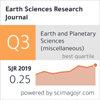基于地球化学和岩石物理资料的哥伦比亚Cesar次盆地南部Los Cuervos组热演化
IF 0.7
4区 地球科学
Q4 GEOSCIENCES, MULTIDISCIPLINARY
引用次数: 0
摘要
后白垩世Cesar-Ranchería盆地所受的构造复杂性导致其油系统的演化发生了变化,Cesar次盆地缺乏始新世至早中新世的地层记录就是证据。这些不再存在的单元可能在这段时间内沉积和侵蚀,在最近的上覆单元上留下了它们的印记。基于上述假设,本研究以ANH-LA lama -2井和ANH-CR-LOS CEREZOS-1X井的古新世地层有机(24 Tmax和14% Ro)和无机(514孔隙度)古地温计数据为基础,研究了始新世至中新世早期盆地的充填情况。除了为本研究所钻的井提供的数据外,还使用了来自Calenturitas和La Jagua矿山Los Cuervos地层的31个已发表的Tmax和13% Ro数据。结果表明,古新世至中始新世确实发生了沉积单元的连续沉积,预计始新诺组沉积单元厚度在2.5 ~ 3.5km之间,具有石英砂岩(密度和压实)特征。根据最近的热年代学研究,这种厚度的岩石在始新世晚期到中新世开始被侵蚀。所获得的证据有助于改进油系统的热演化模型,确定转化比何时取得最大进展,并估计Cesar次盆地最古老的烃源岩目前在研究区内的状态。本文章由计算机程序翻译,如有差异,请以英文原文为准。
Thermal evolution of Los Cuervos formation in the southern area of the Cesar sub-basin (Colombia), based on geochemical and petrophysical data
The tectonic complexity to which the post-Cretaceous Cesar-Ranchería basin has been subjected has generated alterations in the evolution of its oil system, evidence of this is the lack of stratigraphic record in the Cesar sub-basin belonging to ages ranging from the Eocene to the Early Miocene. These units that are no longer present could have been deposited and eroded during this period of time, leaving their mark on the closest overlying units. Previously mentioned hypothesis oriented this research to study how the basin filling was in the time range from the Eocene to the early Miocene based on both organic (24 Tmax and 14 %Ro data) and inorganic (514 data of porosity) paleo-geothermometer data of Paleocene age formations present in two new wells ANH-LA LOMA-2 and ANH-CR-LOS CEREZOS-1X. In addition to the data provided by the wells drilled for this study, 31 published Tmax and 13 %Ro data from Los Cuervos Formation in the Calenturitas and La Jagua Mines were used. The results obtained indicate that the continuous deposition of sedimentary units did occur from the Paleocene to the middle Eocene and it is expected that the Sedimentitas del Eoceno Formation has reached a thickness between 2.5 to 3.5km with characteristics of quartz sandstones (density and compaction). This thickness of rock began to be eroded in the late Eocene to the Miocene according to recent thermo-chronological studies. The evidence obtained allow to improve the thermal evolution models of the oil system, to establish when the greatest advances were made in the transformation ratios and to estimate how the oldest source rocks of the Cesar sub-basin are currently in the studied area.
求助全文
通过发布文献求助,成功后即可免费获取论文全文。
去求助
来源期刊

Earth Sciences Research Journal
地学-地球科学综合
CiteScore
1.50
自引率
0.00%
发文量
0
审稿时长
>12 weeks
期刊介绍:
ESRJ publishes the results from technical and scientific research on various disciplines of Earth Sciences and its interactions with several engineering applications.
Works will only be considered if not previously published anywhere else. Manuscripts must contain information derived from scientific research projects or technical developments. The ideas expressed by publishing in ESRJ are the sole responsibility of the authors.
We gladly consider manuscripts in the following subject areas:
-Geophysics: Seismology, Seismic Prospecting, Gravimetric, Magnetic and Electrical methods.
-Geology: Volcanology, Tectonics, Neotectonics, Geomorphology, Geochemistry, Geothermal Energy, ---Glaciology, Ore Geology, Environmental Geology, Geological Hazards.
-Geodesy: Geodynamics, GPS measurements applied to geological and geophysical problems.
-Basic Sciences and Computer Science applied to Geology and Geophysics.
-Meteorology and Atmospheric Sciences.
-Oceanography.
-Planetary Sciences.
-Engineering: Earthquake Engineering and Seismology Engineering, Geological Engineering, Geotechnics.
 求助内容:
求助内容: 应助结果提醒方式:
应助结果提醒方式:


